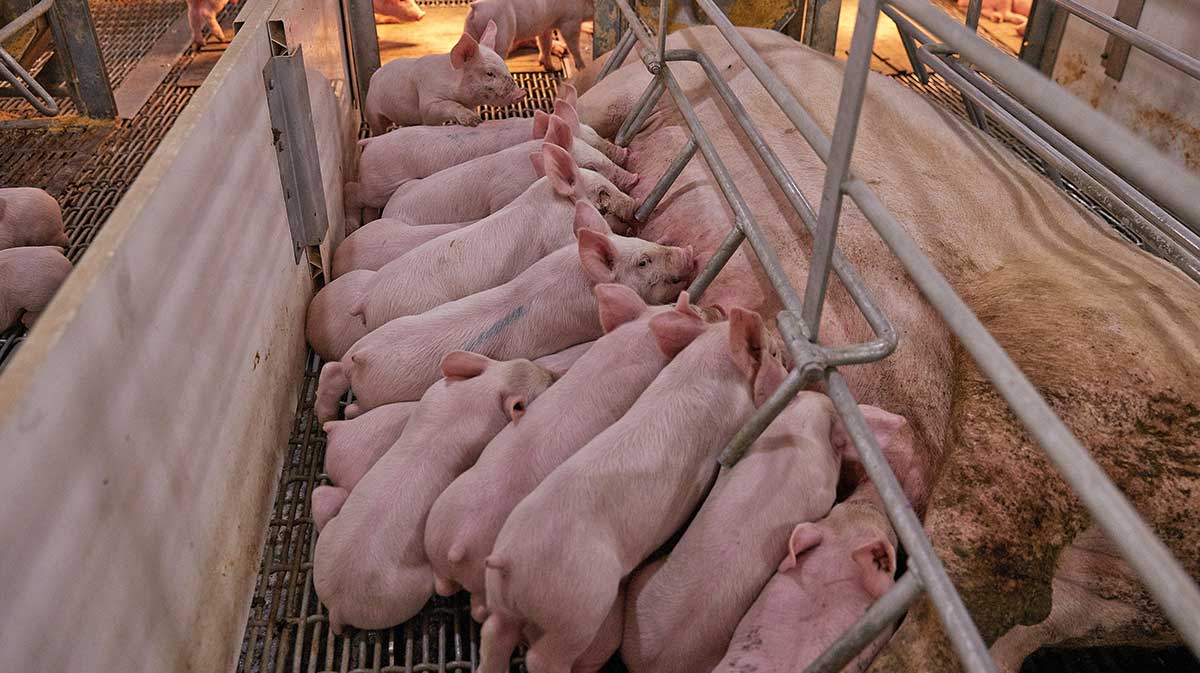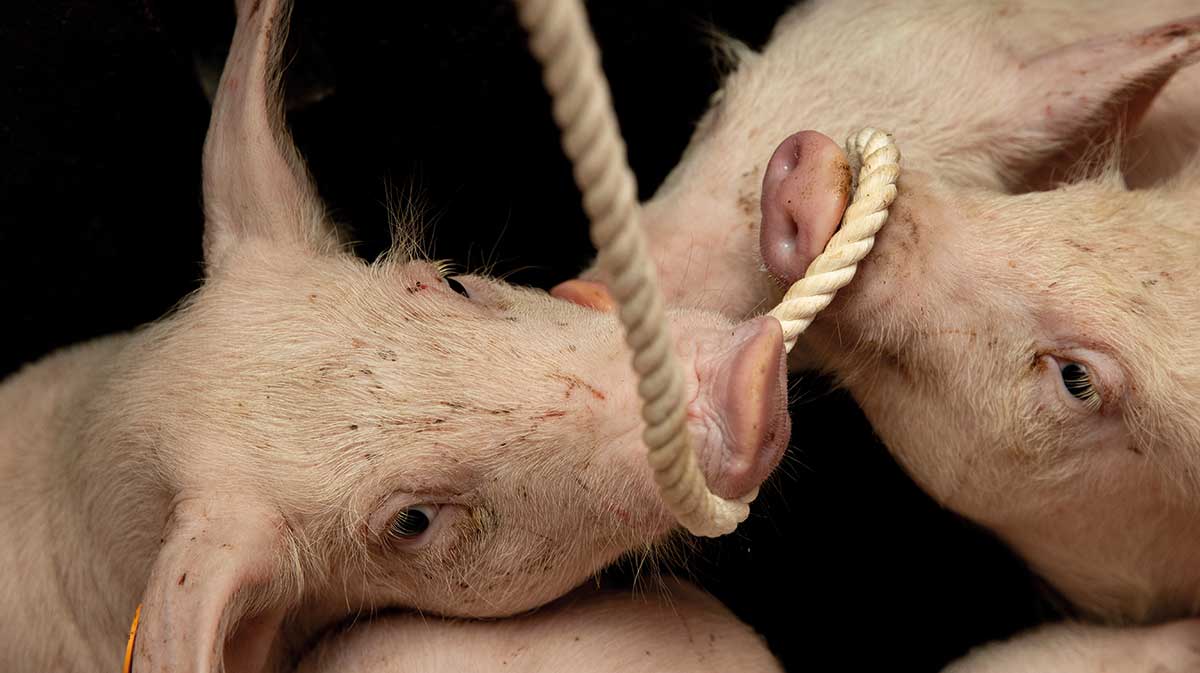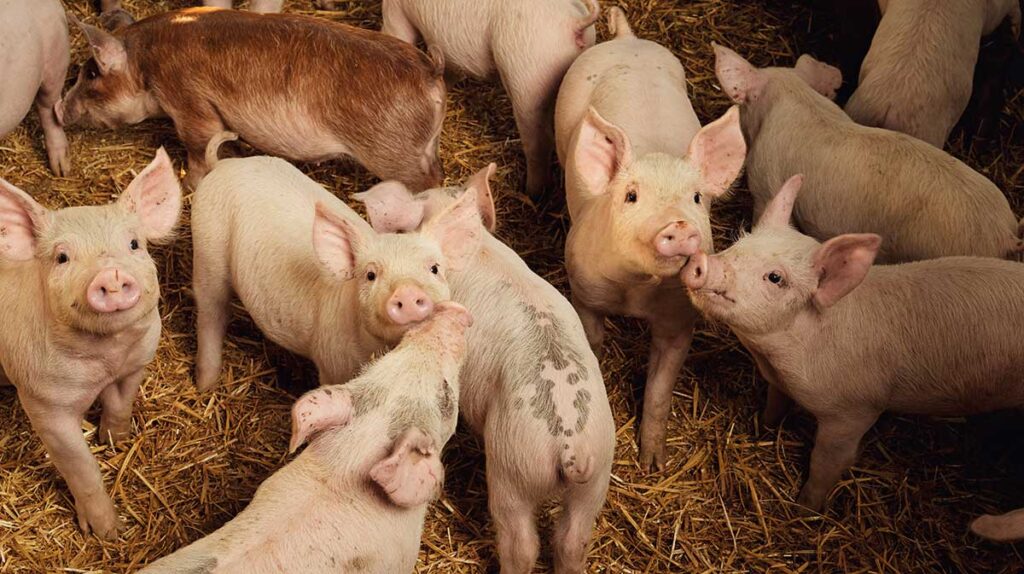Porcine respiratory reproductive syndrome virus (PRRSV) can affect the health and productivity of pigs of all ages and remains one of the most economically important endemic diseases in the UK pig herd and globally.
As such, PRRS is the disease chosen by the government and pig industry as the main focus of the Pig Health and Welfare Pathway, which is delivering Defra funding to producers for endemic disease control.
See also: How to minimise the growing risk of a swine dysentery outbreak
PRRS was also a key topic at the most recent annual two-day CPD event for younger pig vets, hosted by Zoetis, which drew together technical veterinary knowledge to discuss it, alongside swine influenza and porcine circovirus 2 (PCV2)– the ‘big three’ viral diseases affecting pigs.
Impact
“Different PRRSV strains can cause disease of different levels of severity, so pigs with PRRS can show only mild signs, or they can become very ill, depending on the level of immunity to the strain of PRRSV, the management system and the presence of other diseases,” said Zoetis national veterinary manager Dr Laura Hancox.
“It is also the case that if pigs develop immunity to one strain, it does not necessarily protect them against another.”
In a herd which has had no exposure to a particular PRRSV strain and has no immunity to it, sows and gilts may show minimal signs or may seem off colour, become lethargic and stop eating.
Sows may also develop a high temperature, fast breathing and they may get red, purple or blue ears (hence the colloquial name for the disease – ‘blue ear’). Sow mortality ranges between 1% and 4%, which may be related to other concurrent endemic diseases.
Around one week after infection, producers may see reproductive issues, including litters born early, and litters containing a mixture of normal piglets, weak piglets, stillbirths and mummies.
Piglet pre-weaning mortality is high during an acute PRRS outbreak and can reach up to 60% mortality. The piglets may starve because they develop listlessness or due to the sow not producing enough milk and they may also struggle to breathe or show neurological signs.
In naïve growing and finishing pigs, acute PRRSV infection may present, with pigs showing significantly reduced feed intake, lethargy, red, purple or blue extremities, laboured breathing and death. Surviving pigs may end up in variable condition, uneven in growth with rough hair coats.
“In PRRSV-positive herds which have been positive for a while, the clinical signs of acute disease will typically only be seen in occasional outbreaks and in pigs with inadequate immunity, such as in the nursery, in grower and finisher pigs or gilts and younger parity sows,” said Dr Hancox.
Pathway funding for PRRS control
Pig producers can now access Defra endemic disease funding through the Pig Health and Welfare Pathway to help understand and control porcine respiratory reproductive syndrome (PRRS) on their units.
This provides more-in depth diagnostic blood testing for PRRS and producers will also receive advice on the results of the tests, including how to remove disease from their farm and improve their biosecurity.
Producers will be able to access the new funding annually at a set rate of £923 (as of the most recent update in June 2024).
It follows the launch of funded annual veterinary review visits last year, with producers currently able to apply for £684 to pay for an extra bespoke visit from their farm vet.
The Pathway has been co-designed by Defra, pig producers and vets who work together on the Pig Pathway Project Group (PPPG).
Transmission and persistence
PRRSV is classified into two genetically different species: PRRSV-1 and PRRSV-2, formerly known as European and North American, respectively.
Fortunately, diagnostic PCR tests are usually able to immediately distinguish between them.
The virus can be spread to susceptible pigs by direct contact with infected pigs, or indirectly through contact with anything contaminated with the secretions or excretions (saliva, faeces, urine) from an infected pig, such as people’s hands, clothing or boots, vehicles, equipment, manure, used needles, or other contaminated fomites.
Transmission in semen from infected boars is also possible and piglets may be born infected with PRRSV due to in utero infection in infected sows.
PRRSV survives better in cooler, darker and more humid conditions, so the winter months may favour transmission.
Airborne spread can play a role in pig-dense areas, its contribution dependent on the density of infected pigs and the climatic conditions.
Only a small amount of virus is necessary for PRRS infection via skin penetration, which could be from re-used needles, tail docking, teeth clipping, ear notching, tattooing, slap marking, tail biting, ear biting and fighting.
“The diagnostic trend shows that PRRS is a prominent disease diagnosed through the GB surveillance network,” said Susanna Williamson, of the Animal and Plant Health Agency (APHA).
An interactive PRRS dashboard records information on diagnostic submissions in for PRRS between 2012 and 2023.
“The pig takes longer to mount an effective immune response to PRRS infection compared to swine influenza virus,” Dr Williamson said.
“Neutralising antibodies to PRRSV take around three weeks to develop. This is one reason why secondary infections are able to develop and contribute to tissue damage, especially in the lungs, before recovery.
“PRRS has an immunosuppressive effect and can predispose to, or exacerbate, other diseases, including bacterial ones. Thus, uncontrolled PRRS can act as a driver for antimicrobial use.”
The combined data for 2012-2023 shows that streptococcal disease (mainly Streptococcus suis), salmonellosis and disease due to Pasteurella multocida are the three most frequently identified concurrent with PRRS in carcase submissions to the GB surveillance network.

Preventing exotic PRRSV
To date, only PRRSV-1 has been detected in UK pigs. “Recombination events do occur between different strains of PRRSV-1, and live vaccine strains have recombined with field strains,” Dr Williamson explained.
“Field strains have been found with vaccine-like ORF-5 sequences, which is something we would expect. Publications report that recombination of two vaccine strains has also occurred.
“PRRSV-2 tends to be a more virulent genotype, with high pathogenicity PRRSV-2 strains (HP-PRRSV-2) particularly so, as seen in some parts of Asia. Pig producers and vets must take steps to prevent PRRSV-2 and exotic different PRRSV-1 strains coming into the UK pig herd.”
She stressed that any imported live pigs or imported semen needs to be from PRRSV-negative herds and live pigs should test negative for PRRSV before and after importation. The NPA’s live pig import protocol provides information on this.

Diagnosis
There are two main ways to test pigs for evidence of the presence of PRRSV in a herd. The first is to detect the virus, by using a PCR test on tissue samples, saliva or bloods. The second is detection of antibodies in the serum or in saliva from a group of pigs.
The presence of antibodies shows that the pigs have been exposed to PRRS virus sometime in the past and/or they have been vaccinated.
When PRRSV is detected by PCR, sequencing of a variable gene known as ‘open reading frame 5’ (ORF-5) can establish whether it is a field or vaccine-like strain of the PRRS virus. This analysis also shows how related a PRRSV strain is to others that have been sequenced.
“The ORF-5 sequencing provides useful information that can identify or rule out links between outbreaks and identify possible sources,” said Dr Williamson. “It can also help find out whether recrudescence, when PRRSV infection or disease recurs unexpectedly following seemingly successful control, is due to a different strain.”
Diagnosis of disease due to PRRSV uses the PCR test and vets should examine and sample several typically affected pigs or submit them to the APHA surveillance network for post-mortem examination.
“The pathology seen during post-mortem examination of systemic or respiratory disease cases may be suggestive of PRRSV involvement, but is not specific to PRRS. Lesions vary depending on factors including strain virulence, the pig’s age, length of time post-infection, pig immunity and concurrent diseases. Testing is essential to confirm a diagnosis of PRRS,” Dr Williamson added.
Diagnostic investigation into reproductive disease involving abortions, stillbirths and mummies should include examination of whole litters, from which vets can select piglets for testing for PRRSV and other causes.

Preventing PRRSV
All potential routes of entry of PRRSV or other pathogens into a pig herd must be considered. Amongst these, effective biosecurity measures include:
- Herds breeding their own replacement gilts rather than buying them in, or sourcing only from PRRSV-free herds, which are regularly tested
- Only using a single PRRSV-negative semen source/supplier and making sure it regularly tests for PRRS
- Investing in wildlife-proof perimeter fencing, wild bird proofing and rodent and fly control
- Limiting entry of vehicles and ensuring any vehicles entering are cleaned and disinfected
- Maintaining a strict visitor policy, which, on some premises, involves showering in
- Provision of outer clothing and boots dedicated to the unit to staff and visitors
- Avoiding movement of equipment or other fomites between farms
- Air filtration systems are used in some countries to prevent pathogens like PRRSV entering by aerosol. Their use may be difficult on some indoor units and it is not possible for pigs kept outdoors.
To prevent introduction, and, for PRRSV-positive units, to control spread of the virus within a herd or pig unit, the attending veterinarian will make a thorough assessment and give targeted advice suitable for the unit.
Vaccination and stable immunity
Effective control of PRRS relies on achieving stable PRRS immunity in the breeding herd and an appropriate vaccination programme in both sows and young breeding animals can develop this.
“It starts with replacement gilts which can often be the source of PRRS issues due to low immunity to the virus,” said Dr Hancox. “If gilts are properly acclimatised before entering the breeding herd, then stability should be easily maintained.
“This requires development of immunity, either by exposure to PRRS-infected animals or preferably through vaccination with a live vaccine, before the gilts enter the breeding herd to ensure they are not actively excreting virus.”
Exposure or vaccination of gilts at around two to four months of age provides time for the development of immunity and resolution of infection before they enter the breeding herd. “The sow herd should then be regularly boosted to maintain a stable immunity, according to the products SPC and under guidance from their vet,” Dr Hancox added.
It is important that producers consult their herd vet before undertaking a vaccination programme with a live vaccine in pigs that have not been vaccinated or exposed to PRRS previously.
Birth to finishing
During a period of PRRS instability and clinical disease, the priority for pre-weaned piglets is to limit spread among litters. “Restricting cross-fostering to the first 24 hours of life only will help, as well as maintaining strict all-in-all-out policies, so that piglets are not held back or moved from room to room,” said Dr Hancox.
Control of chronic PRRS in the weaned pig population can be difficult and in continuous systems, it can be virtually impossible. The best starting point is to receive PRRS-stable weaned pigs, which relies on the breeding herd management.
“In PRRS-positive pigs, mass live PRRS vaccination and all-in-all-out management is the best strategy,” said Dr Hancox. “Wider control of other endemic disease is also an important way to control the impact of PRRS.”
Mycoplasma hyopneumoniae (enzootic pneumonia), Actinobacillus pleruopneumoniae (APP), Glasseralla parasuis (Glässers), swine influenza and porcine circovirus must all also be well controlled.
Elimination of PRRS can be attempted in different ways, including total depopulation/repopulation, partial depopulation and mass vaccination. Each must be accompanied by strict biosecurity measures in order to prevent reinfection.
“Depopulation and repopulation is the most thorough approach and is very expensive. However, it may be increasingly worthwhile if other disease can also be eliminated,” said Dr Hancox.
More information
- Up-to-date details of the Pig Health and Welfare Pathway and Defra funding for PRRS testing
- Details of the APHA surveillance network
- Biocheck.ugent is a useful biosecurity audit that can help producers, in conjunction with their vet’s advice
- Pig veterinary professionals can contact Zoetis to request access to more information on PRRS on its CPD portal or to find out about this year’s Young Pig Vets conference in November
- Producers should seek advice from their vet if they have concerns or to review health management planning




